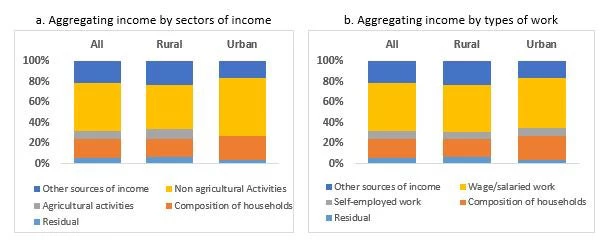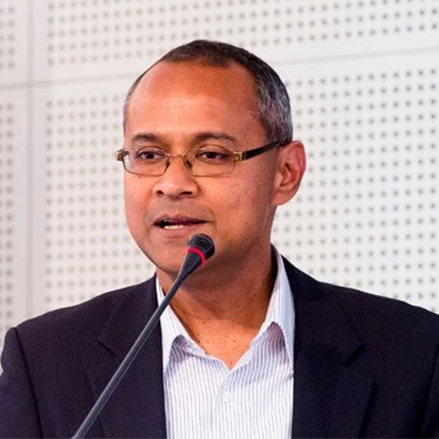
Blog #7: Jobs, not transfers, the big poverty buster
India is home to the largest number of poor people in the world, as well as the largest number of people who have recently escaped poverty. Over the next few weeks, this blog series will highlight recent research from the World Bank and its partners on what has driven poverty reduction, what still stands in the way of progress, and the road to a more prosperous India.
We hope this will spark a conversation around #WhatWillItTake to #EndPoverty in India. Read all the blogs in this series, we look forward to your comments.
The significant shift from farm work to non-farm sources of income accelerated the decline in poverty in India. Non-farm jobs pay more than agricultural labor, and incomes from both were propelled by a steep rise in wages for rural unskilled labor. While lower dependency rates and transfers - from remittances and social programs - have contributed to a reduction in poverty, they are not the primary drivers of the poverty decline between 2005 and 2012.
A previous article in this series examined how India’s structural and spatial transformation—the shift from agriculture to services and industry, and from rural to urban areas—is changing the relationship between economic growth and poverty reduction. We now examine how household incomes grew and helped reduce poverty. We ask how different sources of income contributed to poverty reduction. We also examine how these contributions compare with the effect of changes in the composition of households, including demographic changes.[1]
Our analysis shows that the changes commonly associated with structural transformation were the primary drivers of poverty reduction at the household level during 2005-2012. Increase in labour earnings was a major factor in reducing poverty. While both agricultural and non-agricultural earnings increased, the rise was most rapid for non-agricultural wages and salaried work. This was in turn linked to workers shifting out of agriculture toward wage/salaried non-agricultural work that yields higher earnings. The largest shifts occurred among the poorest, which was accompanied by rising wages in casual employment. In broad sectoral terms, rising income from the non-agricultural sector was the most important driver of the observed changes, contributing to nearly 46 percent of national poverty reduction. In terms of employment categories, changes in wage/salaried work contributed to nearly half of the reduction in poverty.

Note: Contribution of agricultural activities includes: (a) income from agricultural wage employment; (b) income from agricultural self-employment; (c) share of workers in agricultural wage employment; and (d) share of workers in agricultural self-employment; and analogously for the contribution of non-agricultural activities. Contribution of wage/salaried work is the sum of contributions of: (a) income from agricultural wage employment; (b) income from non-agricultural wage employment; (c) share of workers in agricultural wage employment; and (d) share of workers in non-agricultural wage employment; and analogously for the contribution of self-employment. Non-labor income includes remittances, benefits and other income.
Source: IHDS, 2005 and 2012
As expected, there are urban-rural differences. Rising incomes from non-agricultural employment and self-employment were more important for poverty reduction in urban areas. In rural areas, on the other hand, shifts in employment away from agriculture contributed much more to poverty reduction. The pace of transformation was thus more rapid in rural areas, which had a much higher share of employment in agriculture than urban areas to start with.
Changes in the composition of households contributed to poverty decline as well (see figure above). This occurred as the share of working members in households rose. These changes were partly due to a fall in the share of household members who were too young or too old to be of working age; in other words, due to a change in dependency ratios. This demographic dividend makes more workers available at the macro level and complements the structural transformation of the Indian economy.
Rising incomes from other sources - such as public and private transfers, rent, or interest income - contributed to poverty reduction as well. This was more so in rural areas. The largest share of non-labour income came from remittances, which increased significantly. The steep rise in domestic remittances, which form a part of total remittances, suggests that urban and rural areas are becoming increasingly integrated, highlighting another marker for structural transformation.
Thus, faster poverty reduction since 2005 appears to be closely linked to the pattern of structural transformation occurring in India. The falling dependency ratio and, crucially, the steep rise in wages for unskilled work, reinforced the effects of structural transformation. The growth in unskilled wages however occurred due to a somewhat fortuitous confluence of factors, which we will examine in a future article in this series.
Looking ahead, important challenges remain. These include accelerating the speed at which the chronically poor - many of whom belong to Scheduled Tribes - escape poverty. Another challenge is to ramp up the pace of upward mobility so that households increasingly become part of an economically secure middle-class. This calls for the faster creation of higher-productivity jobs. Upcoming articles in this series will examine these challenges in detail.
Reference:
Balcazar Salazar, Carlos Felipe, Sonalde Desai, Rinku Murgai and Ambar Narayan (2016) “Why did Poverty Decline in India? A Nonparametric Decomposition Exercise.” Policy Research Working Paper 7602, World Bank, Washington DC
This blog was originally published in the Indian Express on 17th June, 2016.
***





Join the Conversation